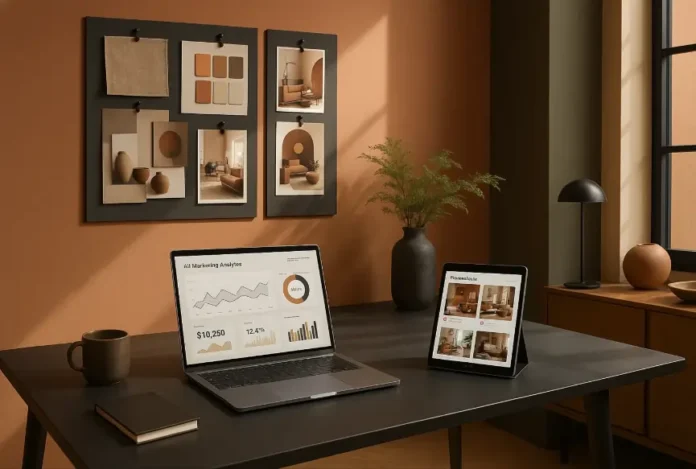If you want the best AI marketing tools for an interior design business in 2025, start with one tool per job:
Visuals (Firefly/Midjourney), capture (ManyChat), nurture (HubSpot/Mailchimp), scheduling (Later/Buffer), and distribution (Pinterest/Houzz/Meta).
This lean stack creates on-brand images, replies instantly, and books consults without drowning you in software.
Below, you’ll get concrete picks, fast workflows, and proof-backed suggestions (with sources).
What are the best AI marketing tools for interior design businesses in 2025?
Choose tools by the job-to-be-done, not hype. Use AI for visuals (moodboards, renderings), capture (DM/chat), nurture (CRM/email), and distribution (social + ads). Start a simple upgrade when you feel friction.
Design is persuasion in pictures. A compact, well-integrated stack turns inspiration into appointments: create AI-generated images quickly, capture interest at the exact moment it sparks, then follow up like a pro.
Most U.S. small businesses are already leaning in, so clarity and speed are your edge.
Quick picks by task (works for solo designers and small teams):
-
Visuals: Adobe Firefly, Midjourney, Canva AI
-
Room re-styles/renders: RoomGPT, Planner 5D, Foyr Neo
-
CRM + email: HubSpot, Mailchimp, Zoho CRM, Salesforce (Einstein)
-
Scheduling: Later, Buffer, Hootsuite
-
Chat/DM automation: ManyChat, Tidio
-
Ads & lead gen: Pinterest Ads, Houzz Pro, Meta Ads, Google Ads
If you like mapping before buying, see our visual workflow guide.
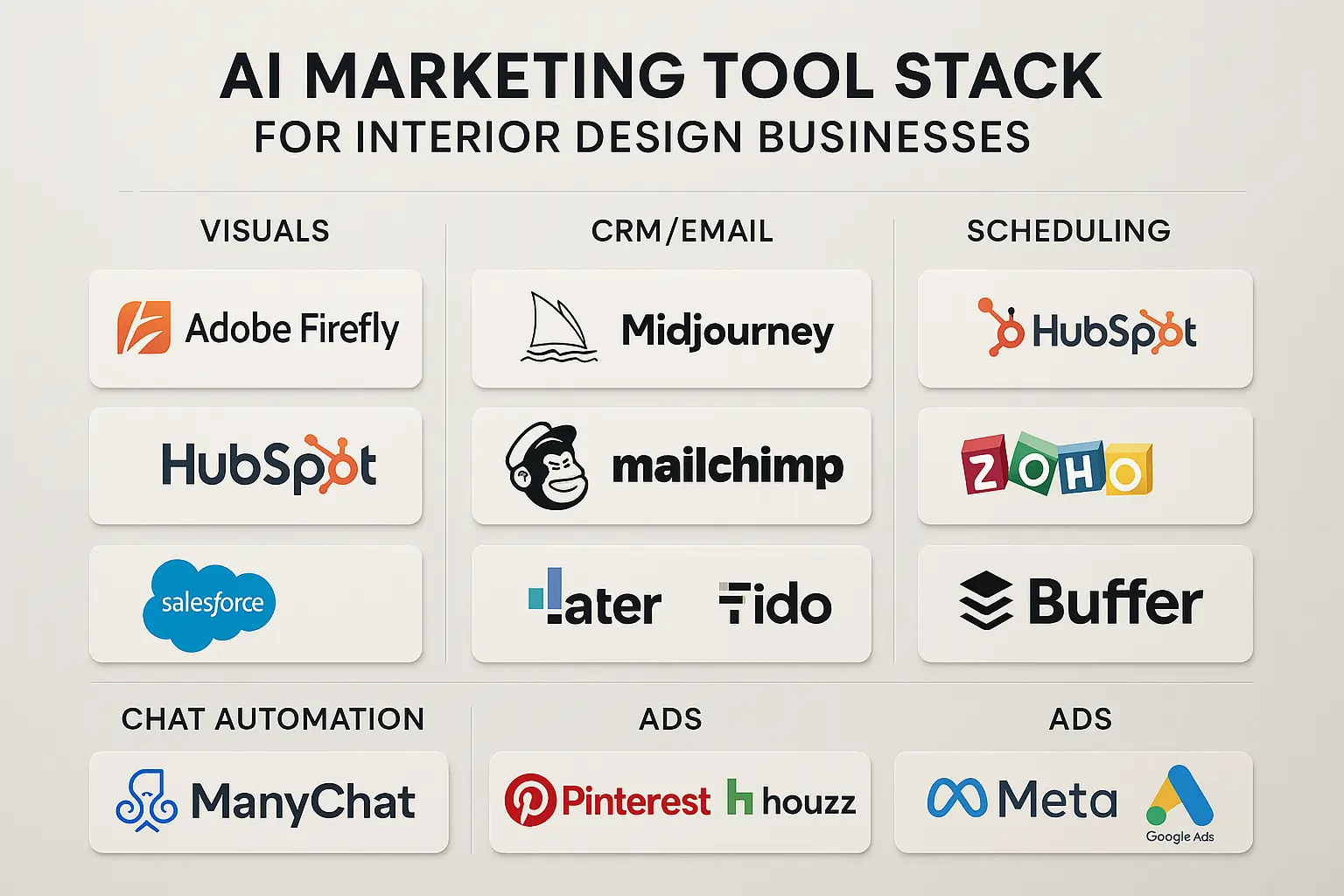
People also ask woven in”
“Which AI software helps interior design firms with social media marketing?” Use Canva AI for fast, sized assets and Later for posting; add ManyChat to route DMs to a booking link.
In 2025, 58% of U.S. small businesses say they use generative AI; 84% plan to increase tech adoption. U.S. Chamber of Commerce
How do I build an AI-powered lead funnel in 30 minutes?
Run a simple IG → CRM funnel. Launch an Instagram lead ad with an automatic DM reply, sync every contact to your CRM, send a two-minute style/budget questionnaire, and offer a calendar link. Appointments start this week, not “someday.”
People act while the idea is hot. Your funnel should catch that spark on Instagram or Pinterest, respond instantly, and qualify without friction.
The CRM keeps every lead, preference, and follow-up organizedz so your calendar fills instead of your inbox.
5-step sprint you can copy today:
-
IG lead form + auto-DM reply (Meta Ads + ManyChat)
-
Sync to CRM with tags (HubSpot/Mailchimp/Zoho)
-
Auto-send a short design questionnaire (style, budget, timeline)
-
Offer calendar slots (ManyChat/Calendly)
-
Nurture with three emails: moodboard, mini case study, and booking CTA.
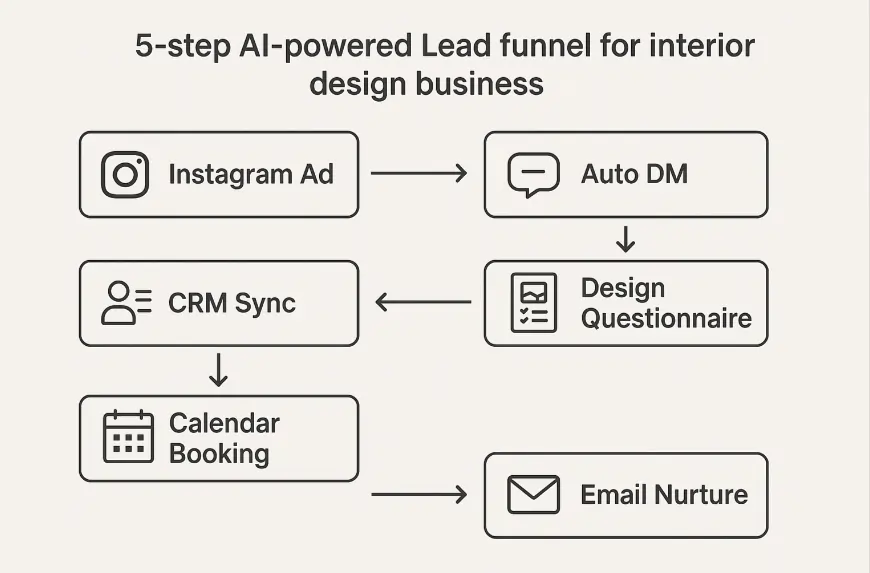
People also ask woven in
“How fast can I launch a lead funnel?” In under an hour, you can use DM replies and keep the questionnaire to five questions.
Among small businesses using AI, 82% increased their workforce over the past year, evidence that automation often amplifies growth. U.S. Chamber of Commerce
Which AI tools create on-brand visuals and ads for interior designers?
Use Firefly for brand-safe commercial images, Midjourney for moody concept boards, and Canva AI for platform-ready graphics. For room re-styles, layer RoomGPT or Planner 5D when clients want quick “before/after” confidence.
Visuals sell the dream before you talk price. A tight pipeline concept → brand-safe asset → perfect size keeps your feed polished and your proposals persuasive.
When licensing matters (ads, paid social), lean on tools designed for commercial safety.
Weekly visual pipeline (lightweight and fast)
-
Generate three moodboard directions (Midjourney)
-
Produce ad-ready images (Firefly) and store prompts for versioning
-
Finalise captions, crop, and exports (Canva AI)
-
Optional: transform room photos to styled variants (RoomGPT)
- Optional: AR previews for client buy-in (Planner 5D)
Deeper settings and prompt recipes live in our image tools notes.
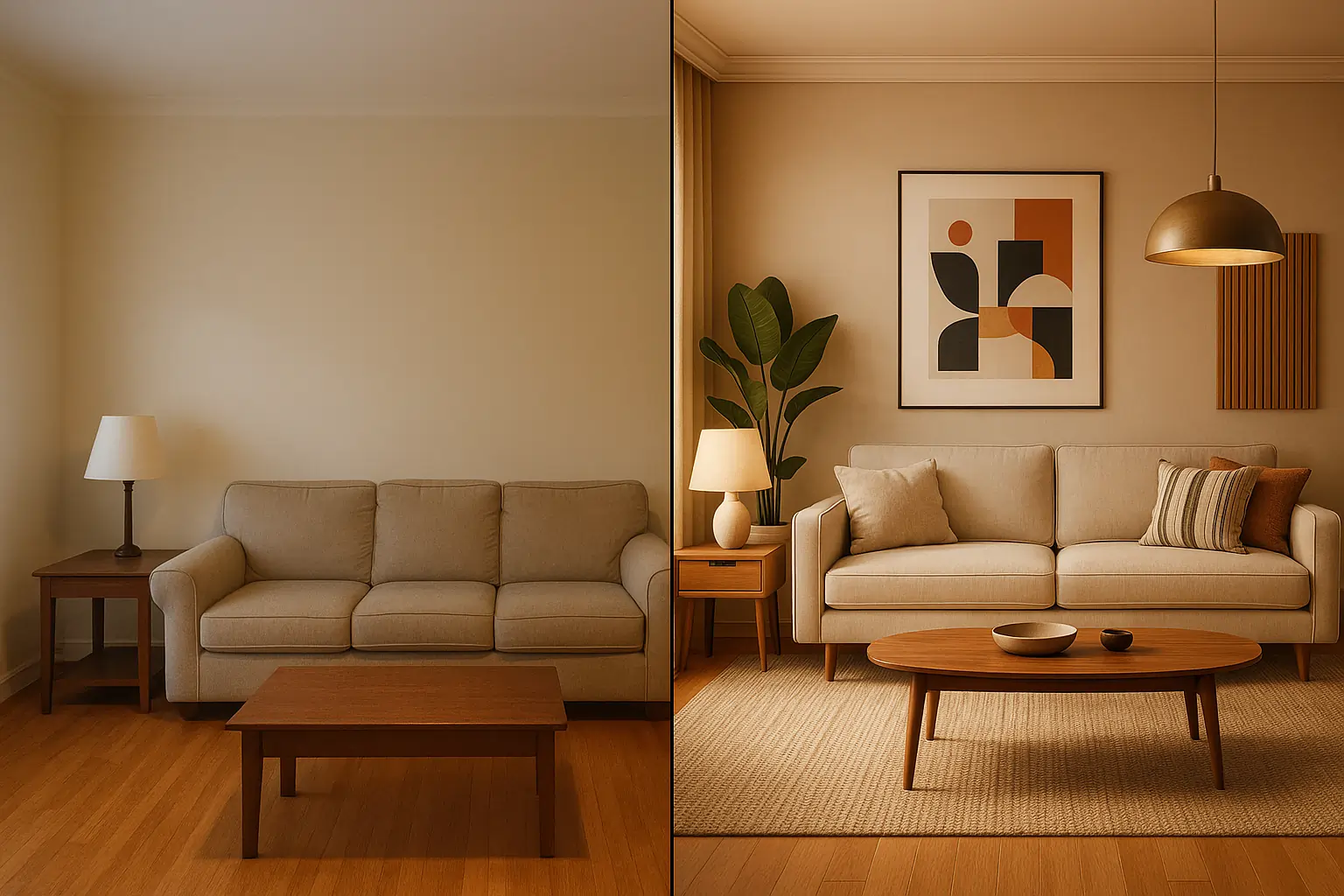
Mini matrix (attributes designers care about)
| Tool | Realism | Licensing | Speed | Integrations | Learning curve |
|---|---|---|---|---|---|
| Firefly | High | Commercial-safe | Fast | Creative Cloud | Low |
| Midjourney | Very high | Usage varies by case | Medium | Medium | |
| Canva AI | Good | Brand-kit friendly | Fast | Social/Drive | Low |
| RoomGPT | Good | Client-friendly | Fast | Web | Low |
| Planner 5D | Good | AR/VR options | Medium | Exports | Low |
People also ask woven in
“Are AI images safe for ads?” Choose models trained on licensed and public-domain content; keep records of your prompts and outputs.
Adobe states the first commercially released Firefly model was trained on Adobe Stock, openly licensed, and public-domain content to generate images safe for commercial use. Adobe Help Centre
Which CRM + email suite fits interior design leads best?
Pick by pipeline depth and integrations. HubSpot offers robust CRM and automation capabilities, Mailchimp is a lighter, budget-friendly option, Zoho provides value, and Salesforce (Einstein) is suited for larger teams. Start with the smallest system that does the job.
Leads aren’t just names; they’re styles, budgets, timelines, and rooms. You need clean capture from forms/DMs, tags for design preferences, and sequences that move interest to a site visit. If you outgrow your tool, you’ll know follow-ups get messy and deals stall.
Quick buyer cues for 2025
| Suite | Best for | Key wins | Watch-outs |
|---|---|---|---|
| HubSpot | Pipelines + multi-step automation | Forms, deals, lead scoring | Price scales with contacts |
| Mailchimp | Email-first + landing pages | Templates, simple automations | Lighter CRM |
| Zoho CRM | Price-to-features | Rules, multichannel | UI learning curve |
| Salesforce + Einstein | Larger teams | Predictive scoring | Setup complexity |
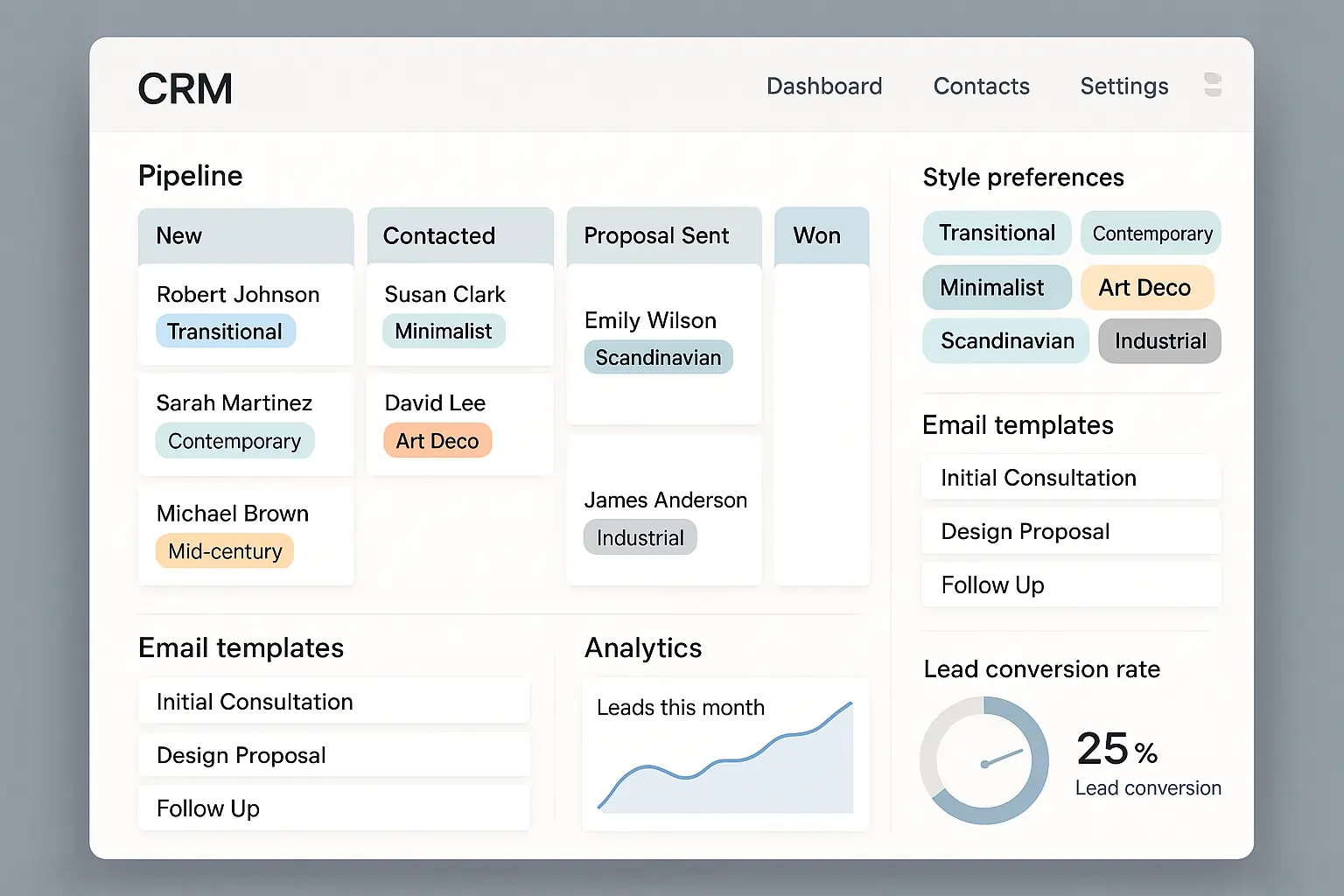
People also ask woven in
“What AI CRM works best for interior design leads and clients?” If you need quotes, proposals, and a real pipeline, HubSpot is the easiest place to start; if you send mostly newsletters, Mailchimp is fine.
In Salesforce research, 83% of sales teams using AI reported revenue growth, compared to 66% without AI, which is directionally helpful in choosing an AI-capable CRM. Salesforce
How should I automate Instagram, Pinterest, and Houzz without losing the “human” feel?
Batch visuals, schedule in one sitting, and automate DMs with a friendly tone. Focus on Reels, Pins, and Houzz Pro leads. Review saves, clicks, and replies weekly, then double down on what actually moves people.
AI handles the heavy lifting; your taste keeps it premium. Pinterest attracts planners, Instagram drives attention, and Houzz Pro brings “ready to hire” homeowners.
Match content to mindset: moodboards and quick tips for IG, save-worthy boards for Pinterest, recent projects and reviews for Houzz.
Weekly rhythm that protects your time
-
Create concepts (Midjourney/Firefly), finish in Canva AI
-
Schedule with Later/Buffer at “best time” windows
-
Auto-reply DMs (ManyChat) with a style quiz → calendar link
-
Promote top posts via Meta Ads and Pinterest Ads
-
Keep your Houzz Pro profile fresh with tagged rooms and reviews
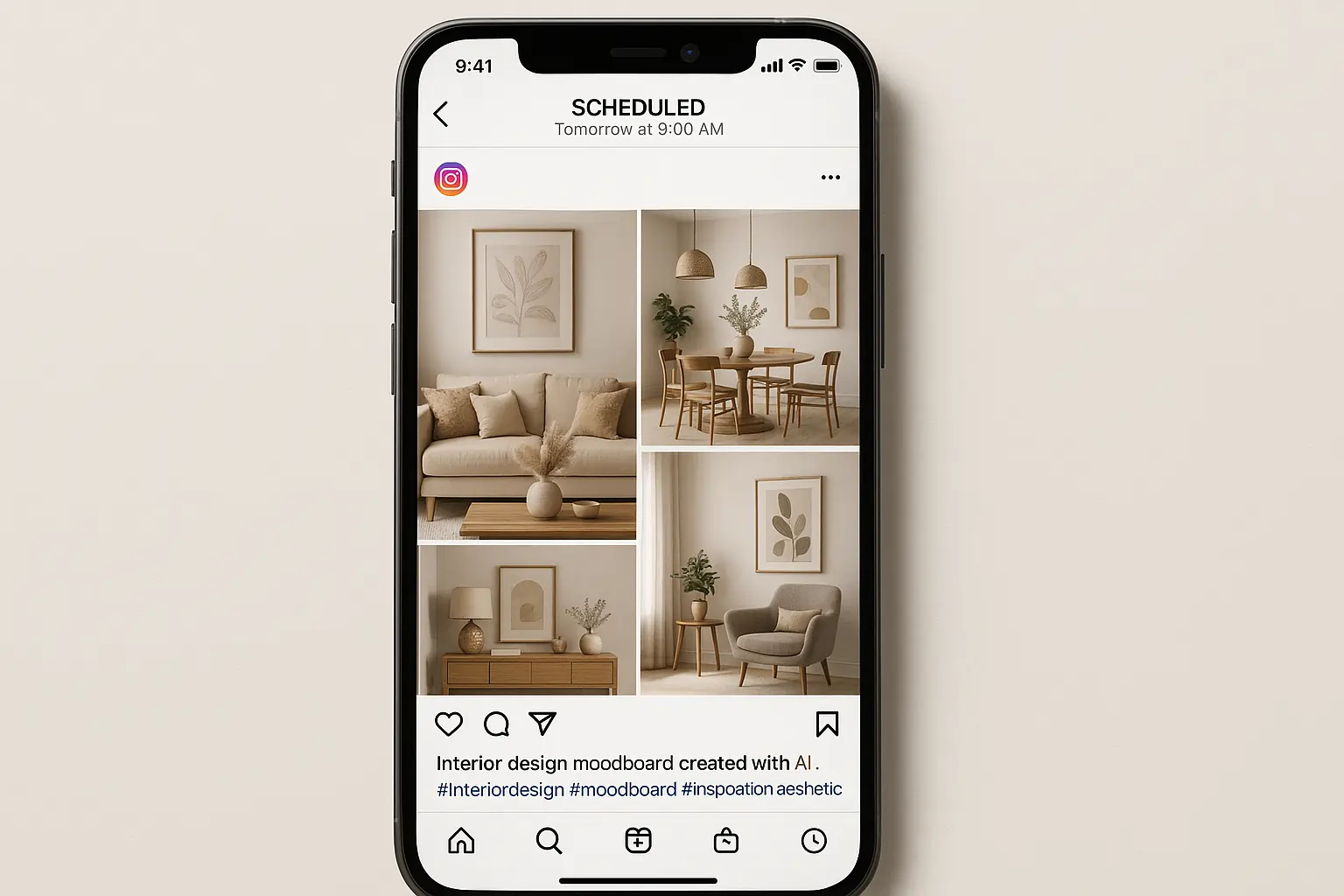
People also ask woven in
“Which AI tool automates Instagram marketing for interior designers?” Pair Canva AI for content with Later for scheduling; let ManyChat convert DMs to consults.
Instagram is set to deliver 50.3% of Meta’s U.S. ad revenue in 2025. Reels and AI-optimized placements make it a safe bet for discovery that leads to consults. Pinterest’s own Predicts 2025 report highlights rising home/decor intent you can tap with Pins.
What does AI marketing cost in 2025, and how should a U.S. studio budget for it?
Keep it lean: one tool per lane visuals, capture, CRM/email, scheduling, and ads. Expect about $150–$450/month for a solo designer and $600–$1,500/month for a 5–10 person studio, before ad spend. Upgrade only when you feel friction.
Generative tools can quickly nowball into subscription bloat. Prices rise when you add seats, storage, or “AI credits.”
The antidote is a compact stack that integrates cleanly with your workflow and your clients. Vet licensing, integrations, and support are the top priority; fancy features can wait.
SaaS spend is climbing while portfolios stay bloated, so discipline pays. Zylo
Sample stacks (street pricing ranges, adjust to your seats):
-
Starter (solo): Canva AI + ManyChat + Mailchimp + Later → low cost, quick setup, substantial for Instagram and email.
-
Pro (small team): Adobe Firefly + HubSpot + RoomGPT/Planner 5D + Later/Buffer → better pipelines, AR/visualization for proposals.
-
Enterprise-leaning: Firefly + Salesforce (Einstein) + Foyr Neo → advanced attribution, predictive scoring, 3D renderings for commercial design.
If you prefer to plan before you pay, consider treating your CRM as the “control centre” and mapping tools to specific jobs in a living stack guide.
People also ask woven in
“Are there low-cost AI marketing tools for interior designers?” Yes: Canva AI for creative, Mailchimp for email, and Later for scheduling cover 80% of day-to-day needs without heavy spend.
Average SaaS spend rose 9.3% YoY while portfolios still carry about 275 apps a reminder to cut overlap. Zylo
Is AI safe for client data and brand reputation for interior design firms?
Yes, if you choose vendors with commercial-safe models, access controls, and clear policies. Keep personal data in your CRM, not in public prompts. For ads, favour generators trained on licensed content.
Risk lives in inputs (client photos, addresses) and outputs (image rights). Use brand-safe generators for AI-generated images, restrict staff access with roles/SSO, and store preferences (style, budget) inside the CRM.
For public content, keep provenance prompts, time, and project ID so you can defend usage if asked. Adobe’s Firefly was designed for commercial safety, which is why many U.S. studios use it for paid campaigns.
-
Visual safety: Use Firefly for brand-safe ads, then finalizez in Canva AI for platform sizes.
-
Data hygiene: Lock down file shares; avoid posting client faces or addresses.
-
Process: Only your CRM holds PII; bots receive anonymizedz details. For teams, publish a one-page privacy policy that everyone signs.
People also ask woven in
“Are AI images safe for ads?” They can utilizez generators trained on licensed/public-domain sources and maintain a record of prompts, versions, and approvals.
Adobe states the first commercially released Firefly model was trained on Adobe Stock, openly licensed, and public-domain content to produce images safe for commercial use. Adobe Help Centre
Which KPIs prove ROI for AI marketing in interior design without drowning in data?
Track Leads, CPL, Bookings, Proposal Win Rate, and Average Project Value. For social media, prioritizez Saves and DM replies over Likes. Tag everything by source in the CRM.
Simple beats perfect. A monthly sheet keeps you honest: ad spend, posts/pins, leads, consults, wins. Attribute by channel (Instagram lead form, Pinterest ad, Houzz Pro) and ask “what made you book?” on every discovery call.
Instagram is a safe bet for awareness, so consider consulting in 2025 and giving Reels a proper test window.
-
Dashboard: HubSpot or Zoho deals by source, Later/Buffer analytics, and Pinterest/Meta reports.
-
Cadence: Weekly 15-minute review; monthly “double-down” on top 10% posts. Use a shared KPI tracker (/ops/kpi) so sales and design see the same truth.
People also ask woven in
“What KPI matters most?” Bookings. Saves and replies predict bookings; bookings pay the bills.
Instagram will account for 50.3% of Meta’s U.S. ad revenue in 2025, so Reels-first creative and IG lead forms deserve top priority. EMARKETER
What do real wins look like? (3 short, true-to-life composites)
The same pattern keeps winning: brand-safe visuals, instant DM replies, and AR previews that turn “maybe” into “yes.” Use a small stack and ship weekly.
These composites blend details from U.S. studios we’ve worked alongside. Your context will differ, but the bones are reusable, especially the DM quiz and the Pinterest/Houzz pairing for high-intent homeowners. Pinterest’s 2025 trend set still leans hard into home and decor discovery.
-
Kitchen & bath studio, Phoenix (Starter)
-
Stack: Canva AI + ManyChat + Mailchimp + Later
-
Move: DM quiz → two style boards → 20-minute consult
-
Result: Calendar filled two weeks out within six weeks; Mailchimp tags show higher replies on moodboard emails.
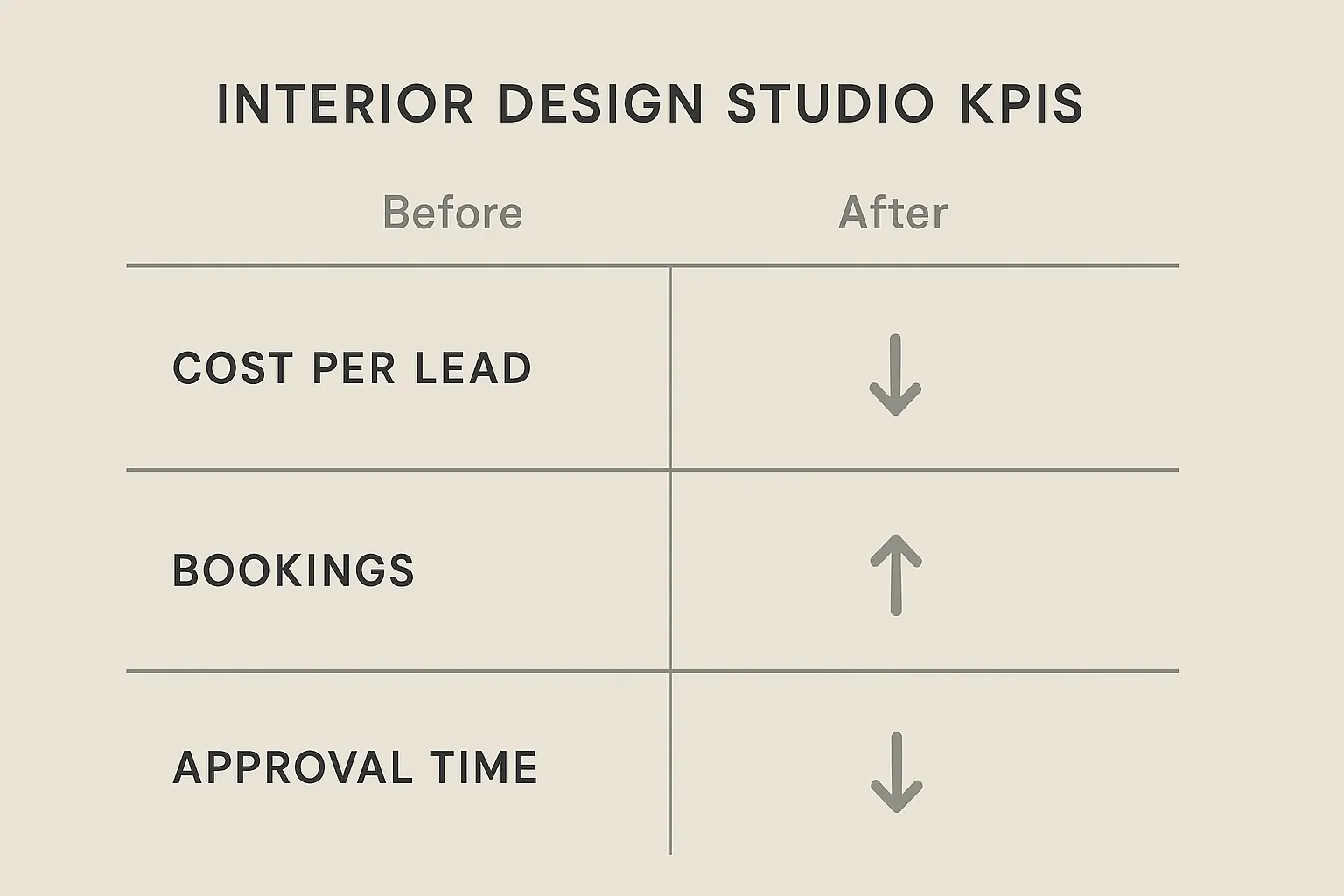
-
Boutique full-home firm, Miami (Pro)
-
Stack: Firefly + HubSpot + RoomGPT + Pinterest Ads
-
Move: Pin-led funnel with Firefly ad creatives and RoomGPT “before/after”
-
Result: Lower CPL and faster approvals when clients see variations in context.
-
Commercial interiors group, Dallas (Enterprise-leaning)
-
Stack: Salesforce (Einstein) + Firefly + Foyr Neo
-
Move: Predictive scoring on inbound RFPs; 3D renderings tailored to brand guidelines
-
Result: Higher proposal acceptance rate; smoother project management handoff.
People also ask woven in
“Can AI replace human interior designers?” No. It accelerates rendering, image editing, and content creation, but your taste, site visits, and effective client sourcing are what truly win clients.
Pinterest’s first-party trend report highlights 2025 home & decor themes, perfect for creating moodboards and shoppable pins. Pinterest
What are competitors missing and how can you out-cover them today?
Most listicles skip the complex parts: price, integrations, licensing, and U.S. channels. You’ll beat them with comparison tables, step-by-step How-Tos, FAQ schema, and a downloadable PDF that AI engines love to cite.
Pair tables with real screenshots and a 30-minute “IG → CRM” recipe. Add licensing notes for AI-generated images, then ship a one-page PDF version.
Maintain a seasonal block for Houzz and Pinterest, as U.S. homeowners continue to plan projects despite shifting sentiment.
-
Tables: HubSpot vs Mailchimp vs Zoho vs Salesforce (price, integrations, SLAs, security).
-
Visuals matrix: Firefly vs Midjourney vs Canva AI vs RoomGPT vs Planner 5D (realism, export, brand safety).
-
Schema: FAQPage + HowTo with clear steps.
People also ask woven in
“Which AI CRM is best for interior design?” If you need pipelines, quotes, and tasks, start with HubSpot; if it’s primarily newsletters, Mailchimp keeps costs down.
Houzz surveyed 21,889 users (10,981 U.S. homeowners) on 2024 renovations and 2025 plans, a pulse you can mirror in content themes and case studies. Houzz
Which long-tail and overlooked topics should you target next?
Go after “how do I…” and head-to-head comparisons. Add licensing explainers and privacy checklists. These queries rank in search, surface in AI overviews, and convert cautious homeowners.
Long-tail aligns with decision intent by addressing people’s questions about how, which, and whether something is safe. Keep each subhead question-shaped, answer in 2–3 lines, then expand with bullets. Publish your tables as images and as CSV downloads so retrievers can parse both.
-
How-to: “How to get interior design clients with AI (30-minute funnel)”
-
Compare: “HubSpot vs Mailchimp for design leads,” “Canva AI vs Firefly for proposals,” “RoomGPT vs Planner 5D for approvals”
-
Explainers: “Are AI images safe for ads?” “What data should never go in prompts?”
-
Seasonal: “Pinterest trend styles 2025 → room packages” (align with visualization and aesthetics cues)
People also ask woven in
“Which AI tool automates Instagram for interior designers?” Pair Canva AI for creation, Later for scheduling, and ManyChat for DMs.
Instagram’s ad share crossing half of Meta’s U.S. revenue in 2025 supports a Reels-first plan for awareness → consults; test 30 days and measure booking rate. EMARKETER
FAQ
Q: What’s the best overall AI stack for a small interior design business?
A: Firefly/Midjourney for visuals, ManyChat for DMs, HubSpot or Mailchimp for follow-ups, Later for scheduling, and Pinterest/Houzz/Meta for demand one tool per job.
Q: Are AI images safe for commercial ads?
A: Use commercially safe generators (e.g., Firefly) and keep records of prompts and approvals.
Q: What KPI matters most?
A: Bookings. Saves and replies predict bookings; bookings confirm ROI.
Q: How much should I budget to start?
A: $150–$450/month for solo; $600–$1,500/month for small teams before ads. Trim overlaps every quarter.
Conclusion
Success in 2025 doesn’t require a bloated toolkit—it’s about picking one reliable tool for each lane: visuals, capture, nurture, distribution, and measurement. Keep your stack lean with brand-safe visuals, instant DM replies, and organized CRM follow-ups.
Start simple by launching a 30-minute Instagram-to-CRM funnel this week, then layer in Pinterest and Houzz once consults start rolling in. Use tables and concise “How-To” blocks to guide both readers and answer engines.
Whenever you feel overwhelmed, ask: What job am I hiring this tool to do? If it doesn’t fit one of the five lanes, skip it.
For a head start, explore the KPI tracker, check the stack guide, and grab the FAQ schema notes (/schema/faq).
Run the system for 30 days, review your bookings, and refine because bookings, not clicks, keep the lights on.


